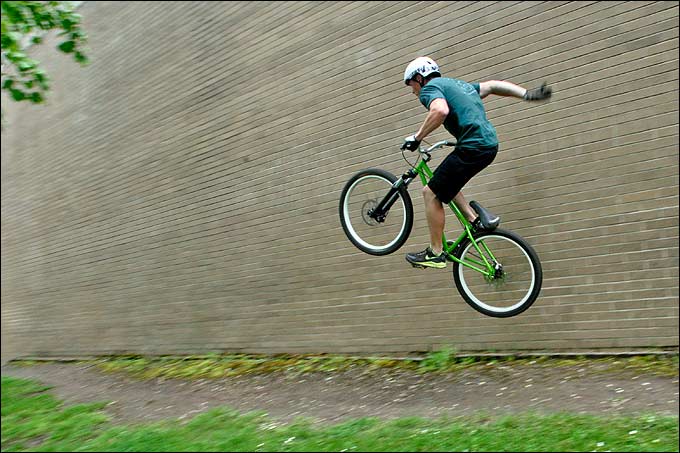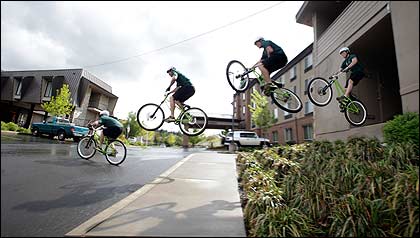
Urban Assault
Bikes get a little wild in the city
Story by Camilla Mortensen | photos by Trask Bedortha
 |
If you’re wandering through town and you see someone on a bike fly by, ride down a railing and leap that bicycle down a flight of concrete steps, you’ve just seen an urban freerider.
Urban freeriding is what happens when mountain biking meets BMX and with a little parkour thrown in. The urban world of buildings, walls, steps, park benches and concrete obstacles is where urban freeriders perform their bike-based stunts.
Local freerider Tad Merrell says, “Elements of urban freeriding include speed through sharp corners and small spaces, dropping off ledges and stairways, wall rides, manuals — wheelies without pedaling, hops — jumping up or over stuff, gaps — jumping over a void, stoppies — balancing on the front wheel, and aerial stunts — stylin’ out air time.”
Merrell says these various stunts can be linked together “in a line, like a train of thought.” A rider can hop his bike, go up into a manual and then drop off of a ledge, and pedal off quickly before anyone starts to yell. Merrell says it’s easy to shed irate pursuers (there are apparently some dubiously legal aspects of the sport, which he says is “frowned on by authorities,”) like cops on bikes because “the Eugene police station doesn’t like them to ride down stairs and stuff like that.”
“You get yelled at a lot,” he says.
The sport originated with mountain biking, and the Northwest — North Shore, British Columbia to be precise — is deemed by some as the place where freeriding on mountain bikes got its start, and certain outdoor stunts are said to be “North Shore style.”
“I personally have been hucking my carcass off of stair sets and small cliffs since I was 14 years old,” Merrell says. “Hucking” is freeride speak for leaping off stuff on your bike.
Cyclists began to incorporate more obstacles like riding across narrow planks over ravines and leaps across large gaps. Their mountain bikes were modified to reflect the more technical nature of the stunts. Urban freeride bikes have a smaller frame to allow for stability in the stunts, and sometimes they have less suspension. A bike with no rear suspension is called a “hardtail,” Merrell says. He began modifying the bike he uses for the sport after breaking parts of it and bending the forks.
Merrell freerides out in the woods; on unofficial dirt courses around town with jumps built by the riders; and everywhere there’s an obstacle in the city of Eugene.
There are no recognized urban freeride competitions, also called urban assault, in the U.S. says Merrell, though there’s a bike race called the “Urban Assault,” which asks the riders to drop their bikes and negotiate various obstacles. Portland will have an Urban Assault race on May 23.
Instead freeriders meet up, perform their stunts and then pedal off before anyone yells too much. Despite the sport’s somewhat illicit nature, Merrell calls it “good clean fun.”
He says people object to it because they’re afraid the riders will get hurt and sue the owner of the property. “Have you heard of something called an ‘attractive nuisance’?” he asks.
“The truth is,” he says, “if we do get hurt, we’re going to keep our mouths shut and move on.”
The conscientious freerider, according to Merrell, always checks to see that there aren’t people around who might get hurt, and looks to see what’s on the other side of an obstacle. “Making other people uncomfortable, that’s just not part of the sport.”
He says the 20 to 30 or so riders in Eugene that he knows of “are as respectful to our surroundings as possible.”
He says ideally, there’s “purely rubber contact,” or in other words, only the tires touch the concrete not metal parts of the bike that might chip the surface.
Ideally the rider doesn’t hit the ground either. Merrell says, “It’s a good survival of the fittest lesson.”